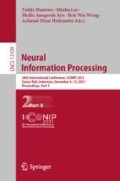Abstract
Social networks have developed rapidly in recent years, which gives people the opportunity to access more information. Nevertheless, social networks are illegally used to spread rumors. To clean up the network environment, rumor early detection is urgent. But the detection accuracy of existing rumor early detection methods is still not high enough in the early stage of news spread. They neglected to focus on more critical tweets by measuring the contribution of each retweet node to news events based on the propagation structure feature. In this paper, a novel method based on Gate Recurrent Unit with Level-Aware Attention Mechanism is proposed to improve the accuracy of rumor early detection. In this method, text features and user features are extracted from tweets about a given news event to generate a unified node representation of each tweet. Meanwhile, the process of news propagation is simulated to encode the node’s forwarding level according to time span and forwarding hops between source tweet and retweet. In order to pay different attention to tweets according to the forwarding level of nodes, a new method based on attention mechanism is proposed to update node representation. Finally, the news event feature is learned from related tweet nodes representation in time sequence via a GRU-based classifier to predict the label (rumor or non-rumor). Extensive experimental results on two real-world public datasets show that the performance of the proposed model is higher than the baseline model in the early stage of rumors spread in the social network.
Access this chapter
Tax calculation will be finalised at checkout
Purchases are for personal use only
References
Arora, S., Liang, Y., Ma, T.: A simple but tough-to-beat baseline for sentence embeddings (2016)
Bahdanau, D., Cho, K., Bengio, Y.: Neural machine translation by jointly learning to align and translate. arXiv preprint arXiv:1409.0473 (2014)
Castillo, C., Mendoza, M., Poblete, B.: Information credibility on twitter. In: Proceedings of the 20th International Conference on World Wide Web, pp. 675–684 (2011)
Khattar, D., Goud, J.S., Gupta, M., Varma, V.: Mvae: Multimodal variational autoencoder for fake news detection. In: The World Wide Web Conference, pp. 2915–2921 (2019)
Khoo, L.M.S., Chieu, H.L., Qian, Z., Jiang, J.: Interpretable rumor detection in microblogs by attending to user interactions. In: Proceedings of the AAAI Conference on Artificial Intelligence, vol. 34, pp. 8783–8790 (2020)
Kumar, S., Carley, K.M.: Tree lstms with convolution units to predict stance and rumor veracity in social media conversations. In: Proceedings of the 57th Annual Meeting of the Association for Computational Linguistics, pp. 5047–5058 (2019)
Lao, A., Shi, C., Yang, Y.: Rumor detection with field of linear and non-linear propagation. In: Proceedings of the Web Conference 2021, pp. 3178–3187 (2021)
Le, Q., Mikolov, T.: Distributed representations of sentences and documents. In: International Conference on Machine Learning, pp. 1188–1196. PMLR (2014)
Liu, Y., Wu, Y.F.B.: Fned: a deep network for fake news early detection on social media. ACM Trans. Inf. Syst. (TOIS) 38, 1–33 (2020)
Ma, J., et al.: Detecting rumors from microblogs with recurrent neural networks (2016)
Ma, J., Gao, W., Wong, K.F.: Rumor detection on twitter with tree-structured recursive neural networks. In: Proceedings of the 56th Annual Meeting of the Association for Computational Linguistics, ACL 2018, Melbourne, Australia, July 15–20, 2018, Vol. 1 Long Papers, Association for Computational Linguistics (2018)
Ruchansky, N., Seo, S., Liu, Y.: Csi: a hybrid deep model for fake news detection. In: Proceedings of the 2017 ACM on Conference on Information and Knowledge Management, pp. 797–806 (2017)
Song, C., Yang, C., Chen, H., Tu, C., Liu, Z., Sun, M.: CED: credible early detection of social media rumors. IEEE Trans. Knowl. Data Eng. 33(8), 3035–3047 (2019)
Srivastava, N., Hinton, G., Krizhevsky, A., Sutskever, I., Salakhutdinov, R.: Dropout: a simple way to prevent neural networks from overfitting. J. Mach. Learn. Res. 15(1), 1929–1958 (2014)
Tripathy, R.M., Bagchi, A., Mehta, S.: A study of rumor control strategies on social networks. In: Proceedings of the 19th ACM International Conference on Information and Knowledge Management, pp. 1817–1820 (2010)
Vishwakarma, D.K., Varshney, D., Yadav, A.: Detection and veracity analysis of fake news via scrapping and authenticating the web search. Cogn. Syst. Res. 58, 217–229 (2019)
Wang, Y., et al.: Weak supervision for fake news detection via reinforcement learning. In: Proceedings of the AAAI Conference on Artificial Intelligence. vol. 34, pp. 516–523 (2020)
Wawer, A., Nielek, R., Wierzbicki, A.: Predicting webpage credibility using linguistic features. In: Proceedings of the 23rd International Conference on World Wide Web, pp. 1135–1140 (2014)
Zeiler, M.D.: Adadelta: an adaptive learning rate method. arXiv preprint arXiv:1212.5701 (2012)
Acknowledgements
This work is supported by National Natural Science Foundation of China (Grant No. 72074036, 62072060), Special Funds for the Central Government to Guide Local Scientific and Technological Development YDZX20195000004725.
Author information
Authors and Affiliations
Corresponding author
Editor information
Editors and Affiliations
Rights and permissions
Copyright information
© 2021 Springer Nature Switzerland AG
About this paper
Cite this paper
Wang, Y., Zhou, W., Wen, J., Zeng, J., He, H., Liu, L. (2021). GRU with Level-Aware Attention for Rumor Early Detection in Social Networks. In: Mantoro, T., Lee, M., Ayu, M.A., Wong, K.W., Hidayanto, A.N. (eds) Neural Information Processing. ICONIP 2021. Lecture Notes in Computer Science(), vol 13109. Springer, Cham. https://doi.org/10.1007/978-3-030-92270-2_47
Download citation
DOI: https://doi.org/10.1007/978-3-030-92270-2_47
Published:
Publisher Name: Springer, Cham
Print ISBN: 978-3-030-92269-6
Online ISBN: 978-3-030-92270-2
eBook Packages: Computer ScienceComputer Science (R0)

